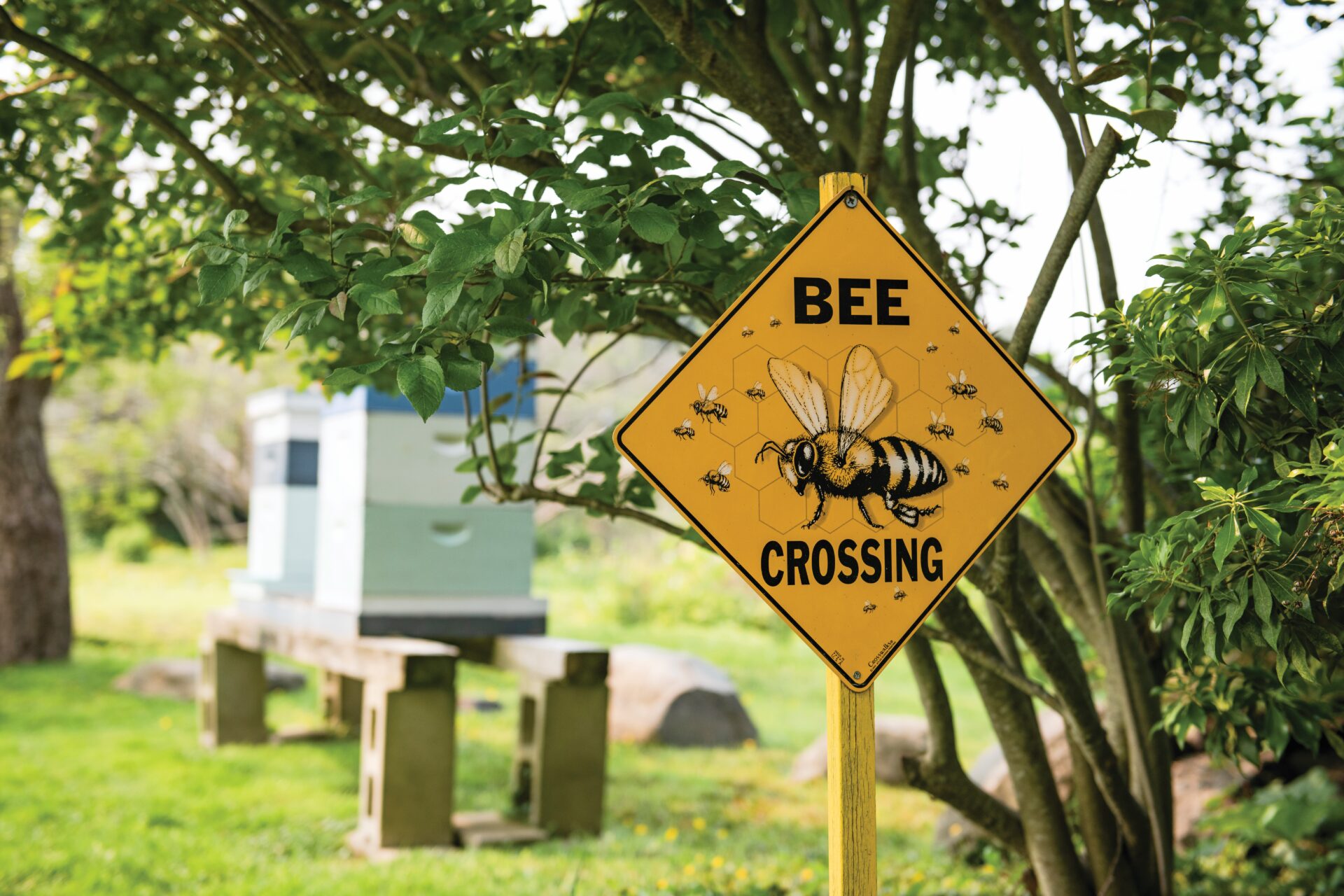Beekeeping: An Intimate Pastime
By Betsy Sherman Walker
Area beekeepers share a love and appreciation for one of nature’s smallest — and most fascinating — creatures: bees
Photos by Cate Brown
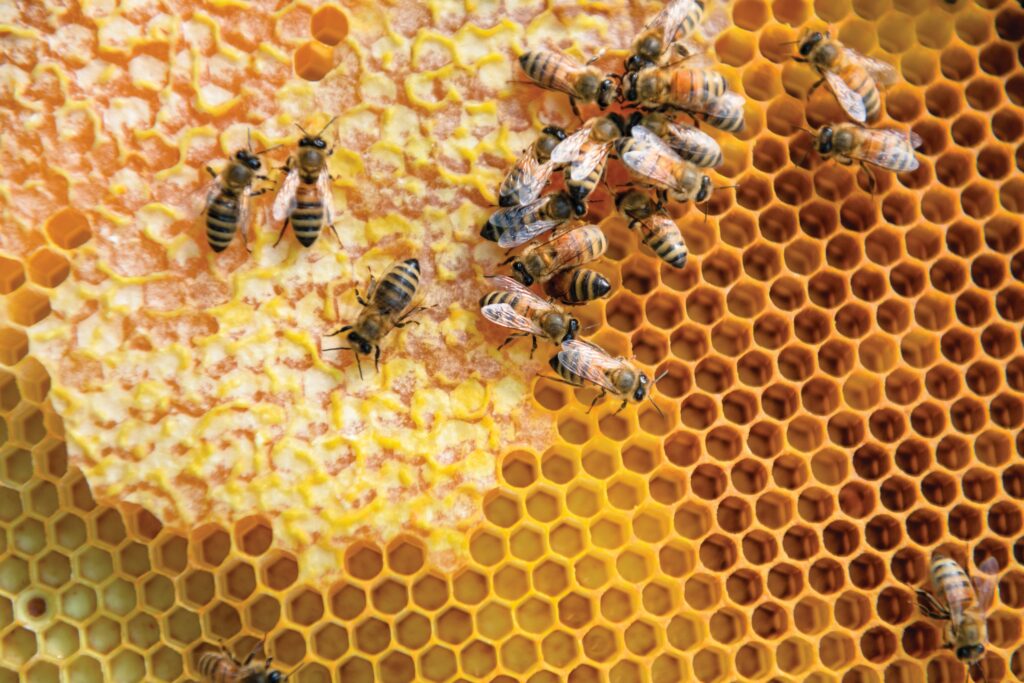
Wherever Mike Hansel has gone throughout his life, his bees have gone with him. For the last 21 years, Hansel has kept his bees on the campus of St. George’s School in Middletown in a field overlooking Second Beach. Hansel, who teaches art and architecture, also spent his childhood at the school, where his father was the chaplain. He first tapped into the world of beekeeping during sixth grade at Gaudet Middle School, with a French teacher who fostered butterflies and kept bees.
“He had a little beekeeper club afterschool,” said Hansel. “There were five of us. It became a lifelong thing for me,” he added. “Wherever I went, I’d get a hive going.”
Hansel returned to St. George’s in 1992. His brother helped him move his hives from New Jersey, where he was living at the time, driving them up I-95in the back of his pickup truck. They arrived late on a foggy summer night.
“We got in at 1 a.m.,” Hansel recalls.
Bees can be super-sensitive to changes in their surroundings, and Hansel had a truckload of agitated ones. “They couldn’t wait to get out of the hive,” he says, “and right away they were attracted to the headlights.”
In the dark of night, the siblings worked to get the bees settled. They were dressed head-to-toe in bee suits, shrouded in the dense ocean mist from the beach below — and engulfed by a swarm of bees.
Unbeknownst to them, 100 yards away the scenario was being watched by one of his new neighbors, who later told him it looked as if a UFO had landed.
In 2008, at the request of some of his students and in a full-circle moment, Hansel started the St. George’s Beekeeping Club. The group named its product Hilltop Honey.
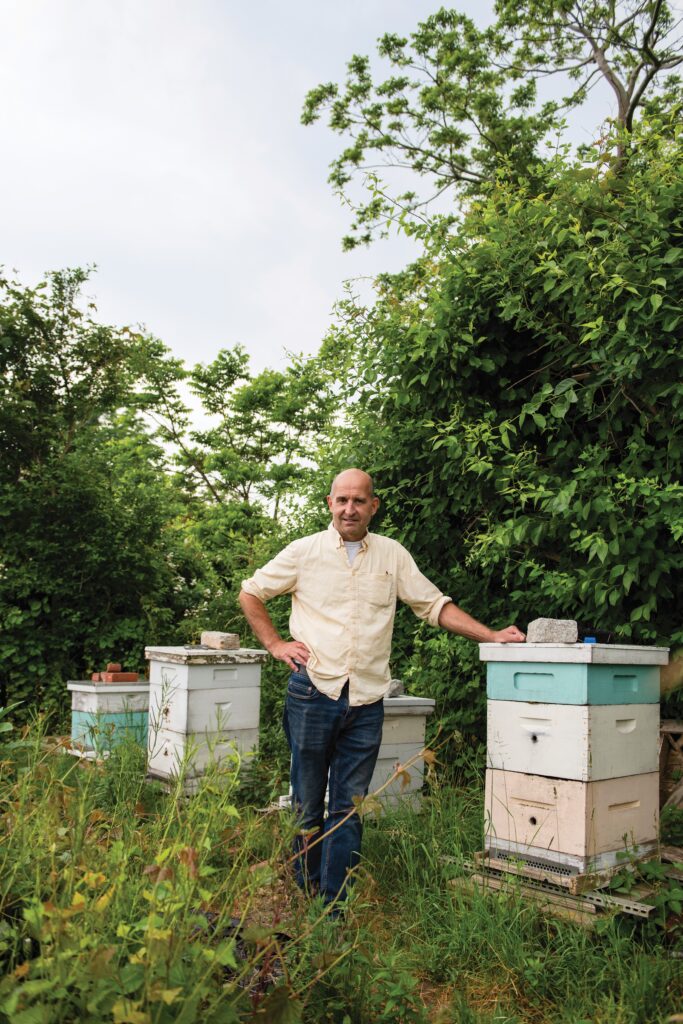
To bee or not to bee
You’re either a bee person, or you’re not. And if you are, your relationship with the bees under your care can run deep and last a lifetime. Like the honeybees they care for (Apis Mellifera, in hive parlance) beekeepers — known as apiarists — are themselves a species apart.
“You have to do it to understand it,” says Robyn Buck, who currently keeps two hives in her backyard in Middletown, and harvests about 45 pounds of honey per year. Buck makes gifts of this honey, which she calls Buck’s Bees, and last September used jars as party favors at her daughter’s wedding.
Buck, who by day is the Office Coordinator of Graduate and Professional Studies at Salve Regina University, is also a lifelong gardener. When her youngest daughter went off to college 11 years ago, she and her husband felt they “needed to find something new.” So, they enrolled in a Wednesday night beekeeping class at the University of Rhode Island.
“It became our date night,” she says, noting it has since evolved into a way of life. “Learning about bees was totally eye-opening,” she added. “I’m forever championing the cause.”
She likens the practice to parenting and considers herself more of a bee-host than a beekeeper, preferring the term “bee-haver.” As long as their living conditions are what they need to thrive, she says, “they really don’t need me.”
Rick Meffert, also a Middletowner, began keeping hives four years ago. The honey they yield is enjoyed by family and friends and as giveaways — as in the time he handed a jar to his somewhat surprised cable TV guy.
Meffert got into it “because I always liked bees. They’re absolutely amazing,” he says. “I wanted something to do, and I love doing this. I saw some other people doing it and decided to give it a try.”
He started with one hive, which was a success. “I decided, this is good.” Emboldened, he added two more hives, which at first did well, until last summer. One of them broke off in a swarm — he couldn’t determine from which hive — and they lost their queen.
Must be the honey
Life in the hive is harsh, with no room for mistakes. Especially for the queen; even she is replaceable. Queens, says Hansel, “are the most productive in the first year,” when they can lay up to 500 eggs a day. “After that most of them start to fizzle out. If a queen starts to fail,” he adds, “the younger, stronger ones will take over. They’ll eliminate her.”
Bees are predictable — until they’re not. It seems as if once you start feeling comfortable, something goes awry. Bees will swarm for a number of reasons — if the hive gets overcrowded, or if the queen is in distress — and she might leave and take a cluster of bees with her. If the queen is deemed the problem, the workers will either move swiftly to replace her with a younger, stronger female — or leave without her.
This summer, Meffert cautiously brought in two new hives. “There is great mortality in the hives,” he says, “because of whatever is being put on [neighboring] lawns. And they have to be fed correctly. It’s quite a maintenance job.”
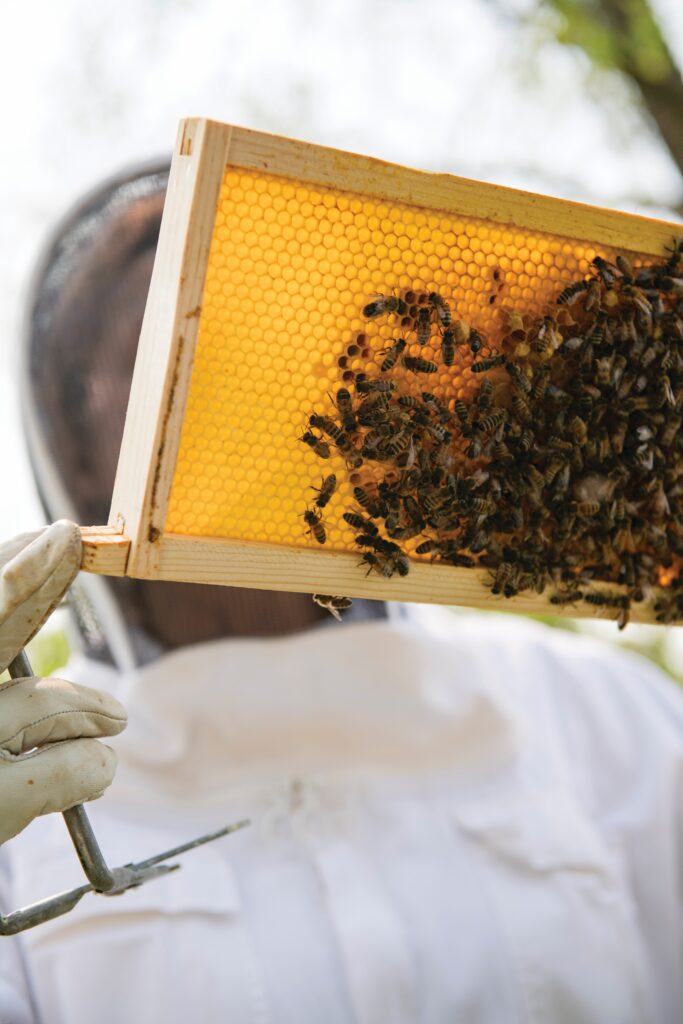
Bee-wisdom also imparts to each a certain persona in how they relate to their hives. If these beekeepers had titles, Hansel would the Bee Master, Buck the Mother Bee, and Meffert the Bee Bro.
None use pesticides, and none are in it to make a profit. Hilltop Honey is sold at the school bookstore and pays for itself, with 20 percent of the proceeds donated to FABNewport, a local nonprofit that works with underserved youth.
Likewise, Helene Van Beuren — whose BadAss Honey is produced in far greater proportions, with a greater yield, and can be found in markets around the island — is not in it for the money.
Her 40-hive apiary is nestled into a section of Vaucluse Farm on Wapping Road in Portsmouth, overlooking the Sakonnet River. The BadAss bees are Carniolan, native to Eastern Europe. On the farm’s website, it’s noted that Carniolans are “relatively gentle in temperament, which makes the beekeeper’s job a little easier.”
On a farm visit in late spring, where the hives are collected in a colorful array of stacked boxes adjacent to a succession of flower beds, there is a little hum going on— the sound of the worker bees foraging. “They’re feisty because it’s spring,” Van Beuren says. “Every queen, every hive, is different. And they behave as a whole unit… It’s hard work. It requires a lot of observation and patience.”
Planted nearest the bees are peonies, about to pop. Next to them, a row of roses. The air is mildly fragrant with the smells of early summer. “We plant according to what they eat,” she says.
Van Beuren is entirely self-taught, and her commentary is helpful for someone in need of bee basics.
“Bees are the only living beings that make their own food,” she says, noting there is a “fine balance” to beekeeping, between “production versus the preservation of bees. How do you do what’s best for the bees? Where do they want to be?”
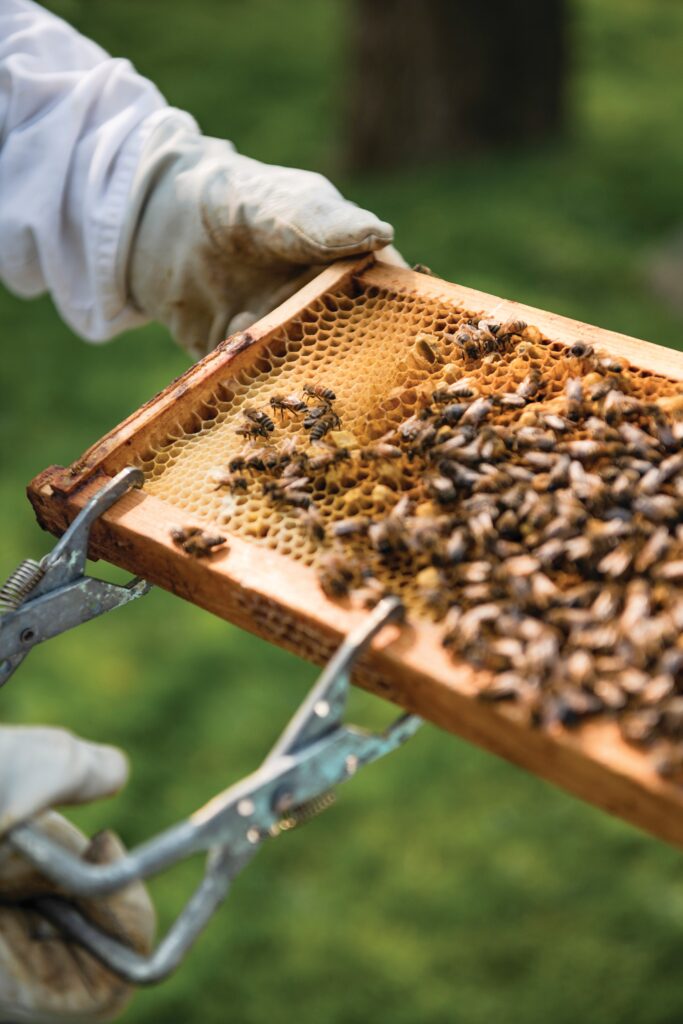
The farm has a honey barn, in the center of which sits the extractor — spotless, gleaming and waiting for the next batch of mature nectar. It is a large stainless-steel tub fitted with a plug at the base. When it spins, the honey — extracted centrifugally — gravitates to the bottom. “The extractor holds 18 frames worth of honey,” Van Beuren says. “We average three pounds of honey per frame.”
BadAss Honey is harvested three times a year — in June, mid-summer, and fall. When the honey is jar-ready, Van Beuren does all the bottling herself, by hand. It’s labor-intensive and slow. The resulting honey is not so much a reward, she says, as it is a source of pure joy.
Van Beuren began dabbling, she says, and turned it into a business, “but I never went into it to make money.” Last year the jar count was 2,000. This year she’s anticipating a greater yield and predicts that 3,000 BadAss jars will be sent out to local distributors.
One of her passions is animal welfare; she has spent time on the board of the Potter League in Middletown, and in similar organizations in Philadelphia. All of the BadAss proceeds go to support spay-neuter programs. The name BadAss refers to the two rescue donkeys — a mother and daughter Miniature Sicilian duo named Lacey and Daisy — who graze serenely nearby, oblivious to their celebrity status. Van Beuren is the Philanthro-Bee.
BadAss also employs a full-time beekeeper, Tony Cochran, who admits that when the hives get active, “the noise does take some getting used to.” Cochran’s main concern is “keeping the bees happy and healthy.” He is well-schooled in bee behavior and content knowing that bees will be bees. “They are smarter than we are,” he says. “It’s wild what they can do. These little things.”
A diligent business
The well-being and survival of “these little things” is serious business. In the Ocean State, three entities work together as watchdogs, advocates, and educators: the Rhode Island Department of Environmental Management, Rhode Island College, and The Rhode Island Beekeeper Association, or RIBA, which was established in 1917 to “raise the quality of beekeeping in RI through education.” RIDEM requires that all beekeepers register their apiaries on an annual basis, no matter how small. By filling out the 12-page application, anyone can have a colony of bees in their back yard. There are 250 registered beekeepers in R.I. Betty Mencucci, the matriarch of RIBA’s Bee School, began teaching beekeeping at RIC in 1992, and is still amazed at what she can learn from bees. “The beginner thinks, ‘I’m just going to set up a hive in my backyard, and I’ll have some honey.’” A lot can happen, she says: People lose interest, or a queen can die and “all of a sudden, it’s over — you have to be very diligent.”
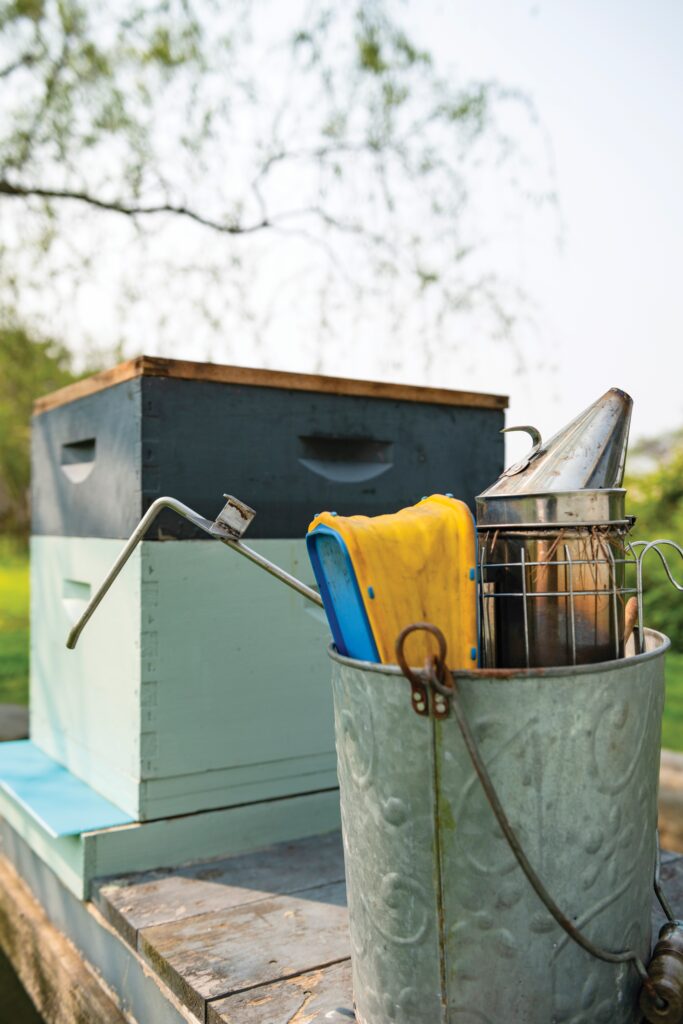
The domestic life of bees
Somewhere between the bee-whisperers and the bee-enforcers there are the bee explainers.
Jim Turenne, the secretary of the Conanicut Island Land Trust and the caretaker of the bees at Jamestown’s Godena Farm, a 25-acre spread owned and operated by the Land Trust, has been keeping and caring for the Godena Honey hives since 2014, when the trust“ inherited” a collection of bee paraphernalia.
And then there is Jim Murphy, the Director of Sustainability at Rhode Island College, who oversees the school’s Bee Education Center, which was established in 2012.
For both Murphy and Turenne, bee-tending is not their day job. Turenne is the state soil scientist for the U.S. Department of Agriculture – Natural Resources Conservation Service. Murphy is the RIC sustainability coordinator who, like Turenne, stepped into his role when equipment was left to the college.
Both channel the wonder of bees and the challenges they present. As bee advocates, they are determined to explain the mysteries of life in the hive, hive health and, increasingly, the urgency of the global welfare of bees.
On a visit to Jamestown in late spring, Turenne was inspecting one of Godena Farm’s three hives (he has had as many as nine), checking up on the queen. Each hive produces 40-50 pounds of honey each year. Once the weather gets warmer, the queen will leave the hive for an outside fling — solely for the purpose of being impregnated.
With that job done, she returns to the hive to lay her eggs, Turenne says, and she is sequestered there, in the bottom-most box, or brood chamber. On top of that sit the supers, where the worker bees work nonstop. The hive is constructed so the queen cannot leave, but the smaller worker bees are able to come and go.
The queen might lay between 1,500 and 2,000 eggs a day. Meanwhile, the worker bees work endlessly during the course of their six-week lifespan. These are the same bees that sting. The “dudes,” as Turenne calls the drones, are doomed from the start — they essentially mate and die. “Their only job is go out during the day and find a queen. But you need them.”
Five years ago, Jim Murphy convinced RIC to install hives in the same enclosure as the college’s five-bed community vegetable garden, with its greenhouse nearby. Once the bees got settled, he says, within the year the honey yield doubled. Today he estimates a bee population of 15,000.
“We extract 200 pounds of honey a year from the hives,” he says. The remainder, importantly, “we leave for the bees, to sustain them through the winter.” The honey goes to the executive chef at the school’s dining hall, where he spins it into honey maple cornbread or a honey-mint balsamic vinaigrette. It’s also presented as a treat to visiting families.
The garden at RIC is also a site for fieldtrips for children in pre-K through high school. On a visit in late May, a group of seventh-graders is taking a tour. “Bees came [to the U.S.] with the Pilgrims,” Murphy tells the group. “Bees pollinate one third of the world’s food supply. Just about everything you eat is pollinated by a honeybee.”
He lifts a frame from the box and shows the students a slice of hive life: the honeycomb cells, deep amber in color, covered with wiggling, vibrating bees. “Bees remain calm,” he explains, “unless you’re a flower.” He points out the cells full of watery nectar, which the bees will top with wax. Over the summer it will percolate into honey.
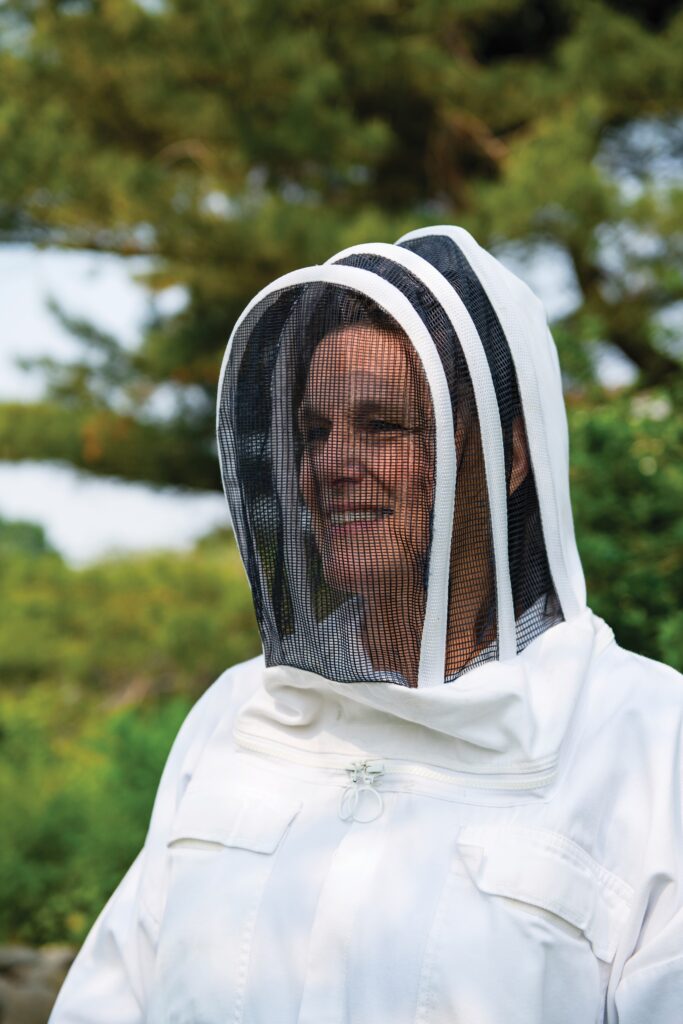
Bee personable — or not
Beekeeping is full of paradoxes. To succeed one must be fearless but cautious, attentive yet hands-offish. Woe be to those who ignore their hives, but neither can one meddle. It must be intimate, but without attachment.
And consider the bee sting. “If you smush a bee,” Buck says, the other bees will know. “You need to wash your bee suit, because they will mark you with a bad smell.” Once, the bees followed Buck into her house and attacked her dog.
Two summers ago, Van Beuren went out to check on what she thought would be a sleepy hive, not wearing her bee suit. “They got pissy and kept stinging me,” she said. “They got in my hair. But I lived to tell the tale.”
Meffert sees the sting as proof of how “amazing” bees are. “I had a hole in my hood,” he says, “and that sucker found it and got under my hood. It was a small hole, and he found it. They mark you, and it tells the other bees where to sting.”
Still, bees seem to bring out mindfulness in people.
Buck thinks “they are a barometer for what is happening around us.”
Meffert admires the way they behave. “If only we could get certain groups in our society to behave like bees…,” he muses.
For Murphy, they are stress relievers. “They get me out of my office, away from a spreadsheet, and let me clear my head,” he says.
Bees, for all of their short lives, are not easily forgotten. At a recent alumni weekend at St. George’s, members of the Class of 2008 returned for their 15th reunion. In that group were Hansel’s first student-beekeepers, who told their former teacher how much they enjoyed it, and what they learned from the experience.
And then, Hansel said with a laugh, “they hit me up for honey.”
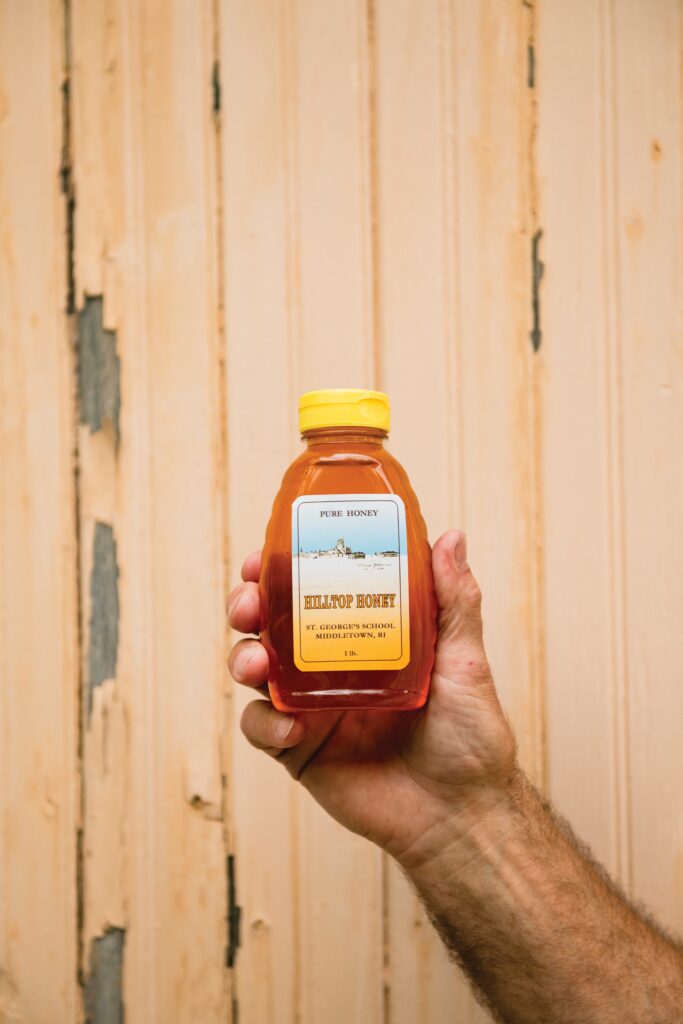
For information on backyard beekeeping and education, go to ribeekeeper.org. To find out more about RIC’s Bee Education Center, click here.

